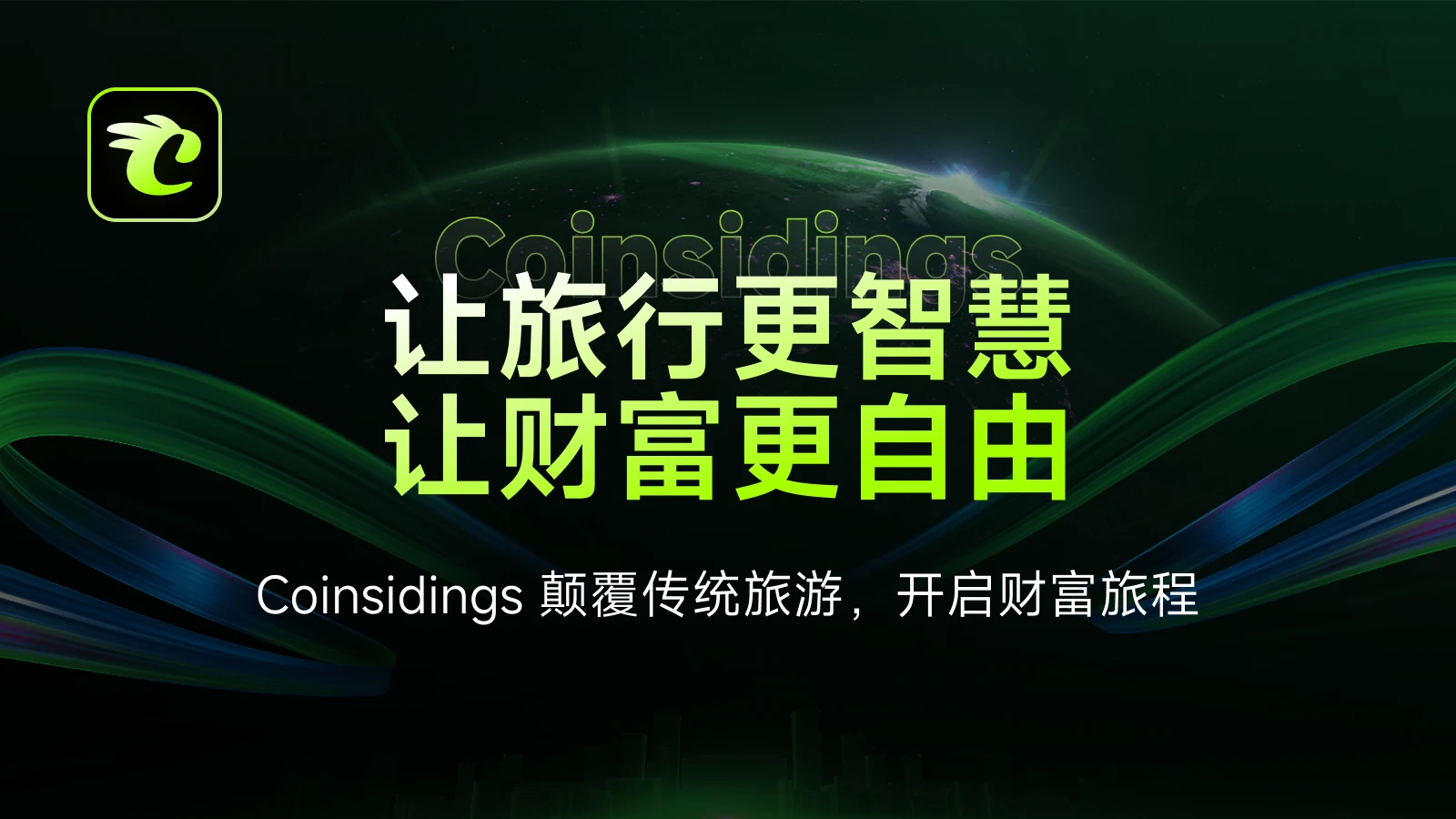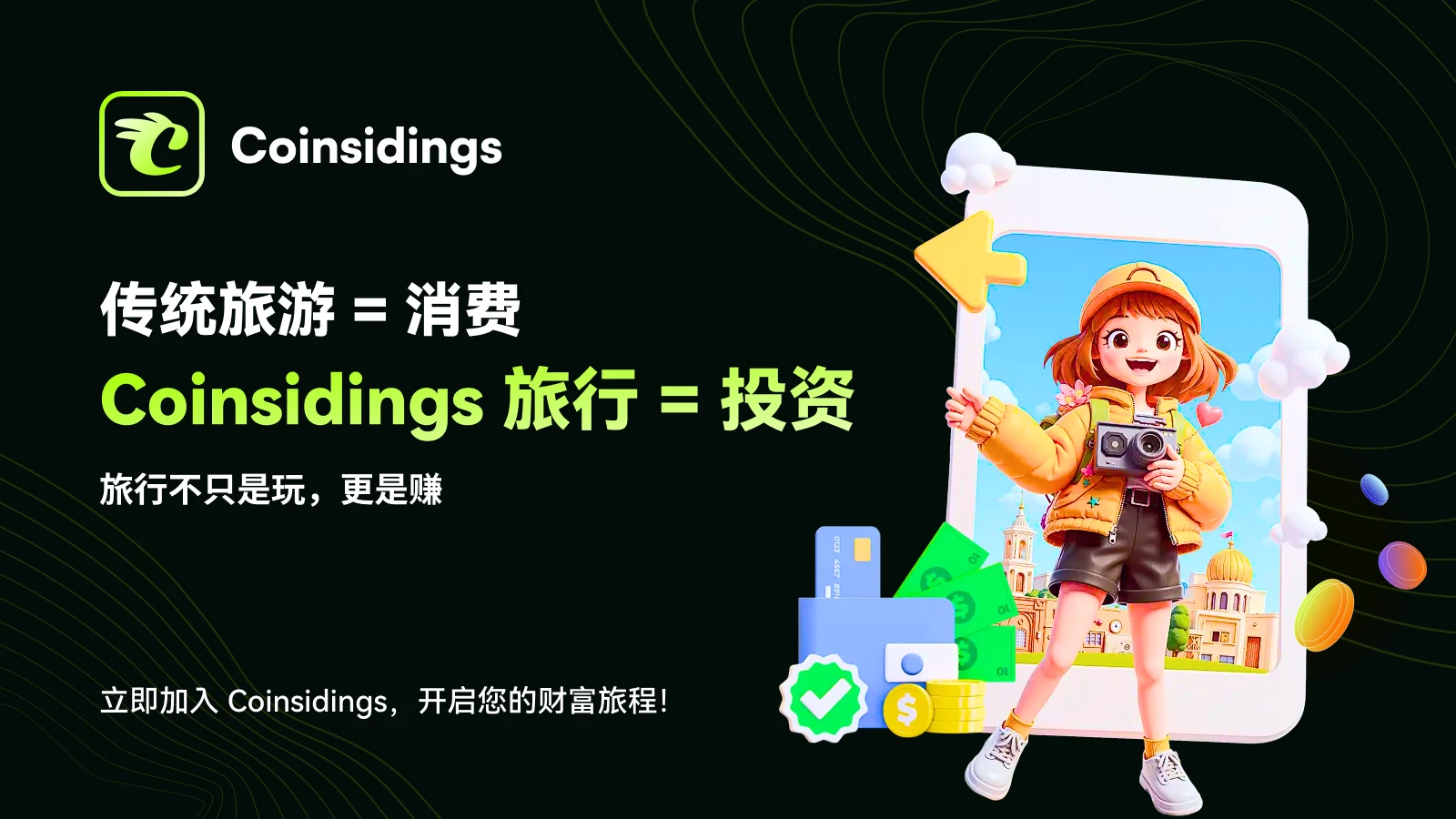At a time when the global tourism industry is accelerating its recovery and transformation, a Web3 ecosystem called Coinsidings is exploring the crypto + tourism track. It is not only a platform that connects users with global tourism resources, but also an ecosystem that implements multiple cutting-edge technology scenarios such as RWA (real assets on the chain), AI itinerary customization, decentralized data rights, smart insurance, and stablecoin payments in real travel.
The Coinsidings ecosystem consists of several core modules, including a stablecoin payment system, a tourism real estate RWA trading platform, a content creation incentive system, an on-chain insurance mechanism, an AI travel assistant, and a smart contract-driven revenue sharing engine. Each module can operate independently and support each other, serving a common purpose: to make travel no longer just a consumption behavior, but a value network that users can participate in, invest in, and share.
Structural opportunities under the recovery of the global tourism industry
According to data from the United Nations World Tourism Organization (UNWTO), the number of international tourists worldwide has recovered to 95% of the pre-pandemic level in 2024, with the Asia-Pacific market growing at a particularly significant rate. At the same time, the new generation of travelers has significantly increased their requirements for depth of experience, data security, transparent consumption and green sustainability, and traditional OTA platforms are unable to meet the diverse needs of this generation of travelers.

This provides the best opportunity for Web3 technology to intervene. The open, transparent, and decentralized characteristics of the crypto industry are naturally in line with the high trust threshold, high value density, and cross-regional collaboration needs of the tourism industry. As one of the first projects to deeply integrate Web3 applications with physical tourism scenarios, Coinsidings has seized this structural opportunity window.
It is like creating a new ecological “map” outside the traditional tourism system. Coinsidings is not simply changing an app to let you book hotels and air tickets, but moving the entire tourism chain—from accommodation, payment, insurance, real estate to data utilization and environmental protection incentives—to the blockchain, and adding the core logic of Web3: transparency, de-intermediation, user co-construction, and benefit sharing.
Coinsidings is reshaping the travel experience
The core of Coinsidingss ability to stand out in the crypto tourism track is its technical support. As a Web3 project focusing on the crypto tourism field, Coinsidings has brought new gameplay and growth opportunities to the tourism industry through the perfect integration of blockchain, AI, RWA (real asset on-chain) and other technologies. From the underlying architecture to the user participation model, Coinsidings is not only a decentralized tourism platform, but more like a scalable and sustainable crypto tourism ecosystem.
Currently, cross-border payment and settlement are the core pain points that many platforms cannot avoid in the global tourism industry. By connecting to the stable currency CHFT, Coinsidings allows users to easily complete global payments without worrying about currency exchange, handling fees, slow arrival, etc. At the same time, the platform also uses smart contracts to automatically handle processes such as orders, compensation, and account splitting, which greatly improves efficiency and reduces the cost of platform operation and user use.

Another key breakthrough is to tokenize real assets such as tourism real estate through RWA. In the past, a homestay might cost millions to invest in. Now, through Coinsidings, users only need to buy one square meter to have the right to share the benefits, and assets can be transferred and exited in the on-chain market at any time. This everyone can participate model lowers the threshold and improves the liquidity and monetization ability of assets.
In addition, the introduction of AI technology has also increased the playability of the platform. When users enter their travel preferences on the platform, AI can generate personalized itineraries and automatically connect the booking processes of air tickets, hotels, insurance, etc., truly achieving travel customization. More importantly, all of this is automatically executed by smart contracts, avoiding the problems of inconsistent services and unclear responsibilities that are common in traditional tourism.
Coinsidings growth engine and ecological flywheel
From the perspective of the entire industry trend, the integration of the tourism industry and blockchain technology is gradually moving towards a deeper level of development. Whether it is the interoperability of the global carbon market, AI-driven real-time price adjustments, or the user credit system built based on on-chain data, these cutting-edge technologies are promoting the full digitalization of tourism services. Coinsidings is standing at the intersection of this change, and with its diversified ecological layout, it has become one of the most representative projects of crypto tourism.
The growth momentum of Coinsidings comes from the virtuous flywheel mechanism formed among users, merchants and the platform. For users, the platform not only provides travel consumption services, but also creates a new travel experience that is investable, participatory and monetizable. Whether participating in tourism real estate RWA or earning income through content contribution, users realize value reflux during travel.
For service providers, Coinsidings provides a complete on-chain infrastructure. They can directly face global users and achieve more accurate marketing and customer retention based on on-chain portraits and incentive mechanisms. At the same time, with the help of the platforms stablecoin settlement system, cross-border operating costs are greatly simplified.
As for the platform itself, as user behavior and transaction data continue to accumulate, high-value on-chain data resources and real assets (RWA) continue to accumulate, laying a solid foundation for subsequent product innovation and ecological expansion. At the same time, the community governance mechanism has gradually matured, forming a governance driving force for sustainable development.
According to unofficial data, Coinsidings currently has more than 200,000 active wallet users, the total value of RWA assets on the platform has exceeded $100 million, and the AI route planning system has covered more than 150 cities around the world. These figures not only reflect the platforms ability to expand rapidly, but also verify the markets recognition of the crypto + tourism model.
Coinsidings is building a participant-driven “co-creation platform”
The ecosystem of Coinsidings goes far beyond providing services to tourists. It is building an open crypto tourism ecosystem in which users, content creators, merchants, and developers participate. This multilateral participation model not only broadens the value boundaries of the platform, but also makes every role a promoter of ecological growth.
For ordinary users, traveling is no longer just a simple consumption behavior, but a new experience of making money while having fun. Tourists can obtain on-chain incentives by publishing travel notes, guides, reviews and other content; they can also participate in the investment of RWA assets such as tourism real estate, or authorize their travel data to the platform for service optimization and obtain corresponding benefits. This new participation model makes travel itself monetizable.
For merchants, Coinsidings provides a set of low-threshold, standardized chain transformation solutions. Whether it is a homestay, a tour guide or a local travel agency, they can quickly access the platforms on-chain settlement system, which supports stable currency collection, automatic account splitting, on-chain insurance policies and other functions. At the same time, the platform provides services such as NFT passes and contract insurance to help merchants achieve Web3 transformation at the lowest cost and expand their business boundaries.

At the developer and ecosystem partner level, Coinsidings also demonstrates a high degree of openness. The platform has opened some protocol interfaces to the outside world, allowing third parties to access custom modules. In the future, whether it is an AI customized itinerary assistant, a carbon neutrality points system, an on-chain ticketing service, or a more immersive tourism metaverse project, it can be seamlessly connected to the Coinsidings ecosystem. This pluggable structure leaves enough room for continued expansion.
Through this complete ecological design, Coinsidings not only breaks through the boundaries of tourism, technology and investment, but also promotes the formation of a new crypto tourism social structure.
Solid technology and active ecology are the two-wheel drive of Coinsidings to leverage the future of the industry
As the tourism industry accelerates its embrace of Web3, Coinsidings provides a new way of experience that is enjoyable, profitable, and fun. From payment settlement to asset investment, from smart contracts to content incentives, this platform is building a complete encrypted tourism ecological network, and also shows great potential to become a leading project in this field.
It is not a simple version of tourism on the blockchain, but it is reconstructing the participation mechanism, trust logic and profit distribution method of the tourism industry. Technically, it connects AI, RWA, smart contracts, and stablecoin payments; ecologically, it allows users to become value creators through incentive mechanisms. With the trend of increasing integration of Web3 and the real world in the future, Coinsidings has the potential to become the first ecosystem of crypto tourism.
With the accelerated recovery of tourism, the popularization of Web3 infrastructure, and the gradual clarification of policies on RWA and stablecoins, projects like Coinsidings that have the characteristics of real scenarios + technology implementation + user-driven will be expected to break the monopoly of centralized platforms and redistribute the interests and power in the tourism value chain.
In the final analysis, Coinsidings is not a Web3 patch for the tourism industry, but a system builder that redefines the way the tourism industry operates based on the underlying logic of travel is an asset and users are value. It is not only a platform, but also the beginning of a new tourism value network.
Coinsidings is not only transforming tourism, but also reshaping the way people go out and connect with the world.
In the future, when users are soaking in hot springs in Tokyo, camping in Morocco, or skiing in the mountains of Switzerland, they can also check their income on the chain and participate in ecological governance. This model of creating value while traveling will no longer be just a fantasy of the crypto circle, but a common reality for tourists around the world.










